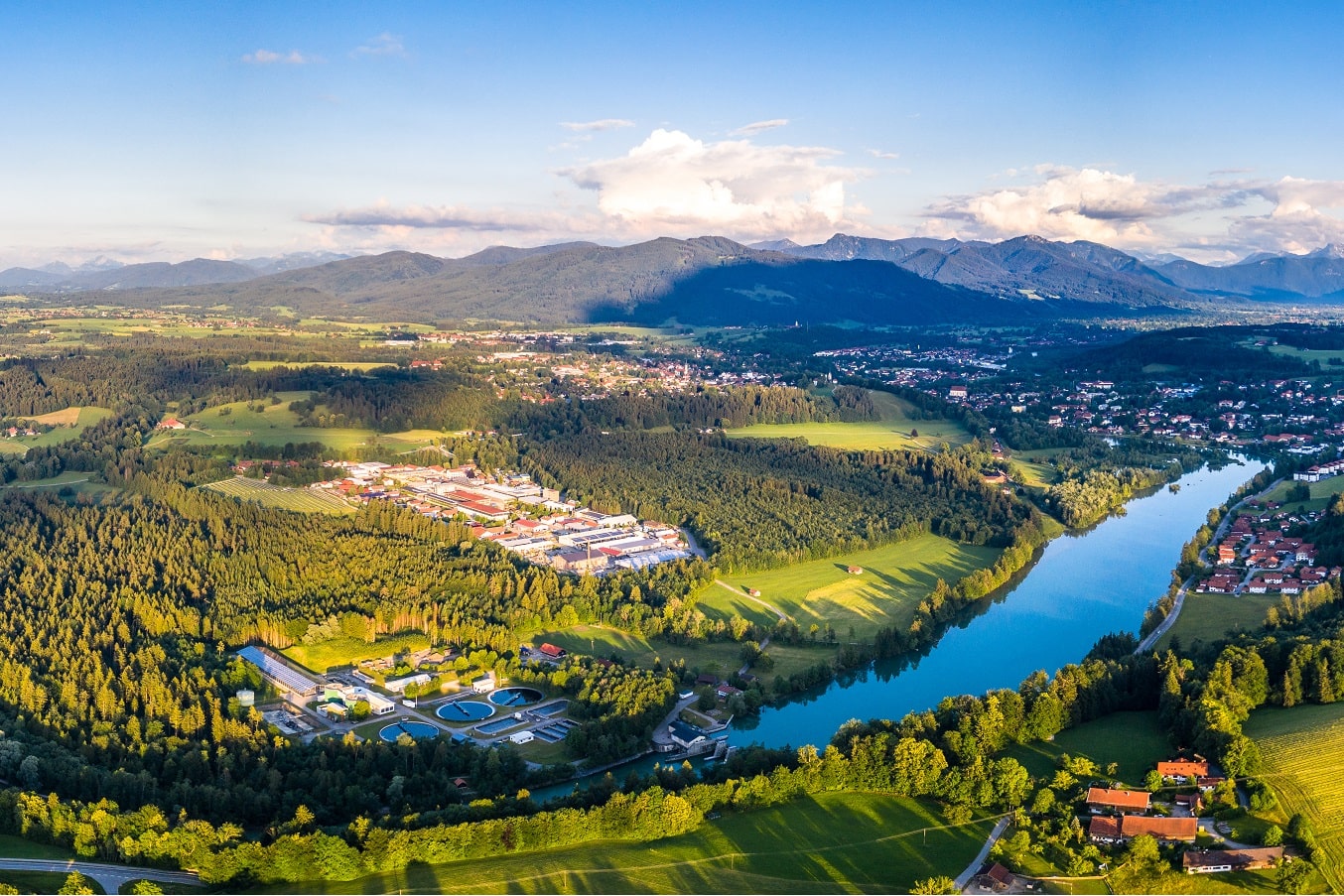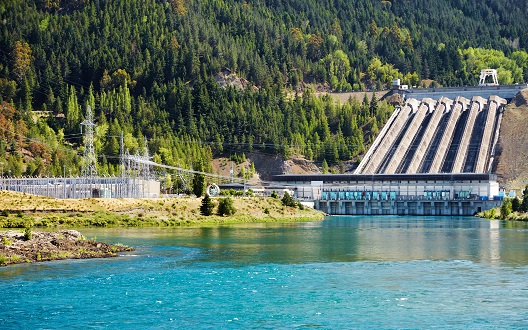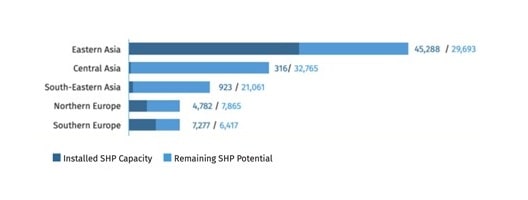Unleashing the Potential of Small Hydropower

Foreword
Globally, we are at a crossroads, facing unprecedented environmental and social challenges that require immediate action. Fortunately, technology that can help solve many of these problems already exists - and can be implemented immediately - in the form of small hydropower.
Small hydropower is more than just a source of renewable energy. It possesses the power to transform entire communities by providing access to electricity and
stimulating economic growth. It can help reduce our dependence on fossil fuels and mitigate the impact of climate change. And it can empower people to take control of their own energy needs, improving their quality of life and building sustainable futures.
As we work to address the challenges of the 21st century, we must embrace small hydropower. We must invest in research and development while encouraging innovation and entrepreneurship to create a future that is both sustainable and equitable for all. We have the tools, the knowledge and the passion to make a real difference. Let’s seize this opportunity and harness the remarkable capacity of small hydropower to create a better world for ourselves and future generations.
Farzad Ferdos
Senior CFD Expert & Technical Specialist – Water Infrastructure & Hydropower
Global Application Engineering & Training, Xylem
Meeting clean energy goals will demand more from all renewables
The impacts of climate change today are impossible to ignore. As a result, countries around the world are prioritising renewable energy initiatives, with many committing to net-zero greenhouse gas (GHG) emissions by 2050.1 The world’s dependence on fossil fuels has also come under intense scrutiny, further accelerating the need to transition to clean energy.
To achieve these ambitious goals - and quickly - every possible source of renewable energy must be leveraged. While much focus has been placed on expanding the conversion of electricity production from fossil fuel to wind and solar, it is essential that we continue to explore new ways of generating electricity using sustainable hydropower.

Seizing the Power of Hydro
Hydroelectric power, or hydropower, is a massively underestimated resource. It is the world’s largest renewable energy source, accounting for one-sixth of global electricity generation — more than all other renewables combined. It is also one of the oldest sources of renewable energy, dating back to the 1800s.
Hydropower uses the natural flow of moving water to generate electricity, making it a continuous source of energy that is readily available. It’s also dispatchable, meaning you can switch it on and off as necessary, offering much-needed flexibility for today’s needs and increasingly unpredictable weather.
These features make hydropower the perfect complement to more intermittent sources of renewable energy like wind and solar, helping to ensure electricity availability 24 hours a day, seven days a week.
However, in advancing towards our climate change goals, we are falling short of the hydropower development needed.
Large hydropower plants (those that generate more than 30 megawatts [MW]) will undoubtedly continue to play a pivotal role in revolutionising our energy production strategy. Small hydropower plants (those that generate 100 kilowatts [kW] to 10 MW) are often overlooked as a renewable energy source. Yet they have an important - if not essential - role to play.
Small hydropower: Huge possibilities
Most small hydropower plants are run-of-river systems, meaning they use the natural flow of small rivers or streams to generate electricity. However, today’s small hydro turbines can also be installed to produce energy wherever there’s a consistent flow of water, opening up a huge raft of possibilities. This includes existing water infrastructure such as old water mills and wastewater treatment plants.
Connecting small hydro turbines to existing systems provides renewable, plannable energy without the need for new infrastructure or dams. This effectively eliminates the environmental impact of new construction and keeps water flows unaffected.
Massive global potential
Around the world, 60 percent of small hydropower potential remains untapped, with large opportunities existing across Asia and Europe.
Share of Global Small Hydropower Potential of ≤ 10 MW by Continent (%)

Developed and Remaining Small Hydropower Potential of ≤10 MW by Region (MW)

Around the world, there are countless potential installation sites that remain untapped, especially in remote and off the-grid areas. Small hydropower can have an especially substantial impact in these locations, providing jobs and income. In countries like Indonesia, Vietnam and the Philippines, small hydropower projects can help to increase electrification rates and reduce dependence on fossil fuels.
Many Asian countries are already using small hydropower successfully today
- In Japan, small hydropower plays an important role in rural electrification and off-grid power supply. The total installed capacity is currently estimated to be around 3,400 MW. Most of the projects are located in mountainous regions,6 with many additional potential sites spread across Japan.
- Korea also uses small hydropower in rural electrification and off-grid power supply. The total installed capacity is currently estimated to be around 620 MW. Most of the projects are located in rural areas,7 with many additional potential sites spread across Korea.
- There are some small-scale hydropower projects in Hong Kong, China, that use water from streams and reservoirs to generate electricity, including the Shek Pik Reservoir, which has a capacity of 1.5 MW.
Putting small hydropower to work for you
The benefits of small hydropower are clear. It’s a renewable energy source that simultaneously maximises production and minimises the overall carbon footprint. So how can you bring these advantages to your projects? It’s easier - and quicker - than you might think. We’ve identified three powerful strategies to help you tap into the full potential of small hydropower now:
Modernise. Innovate. Optimise.
Before beginning any new small hydropower project, it is imperative for developers to engage with local communities and conduct thorough assessments to ensure that social and environmental impacts are minimised.
Modernise: Reimagining what’s old as new
The John Hart Dam in British Columbia, Canada, was recently upgraded to a run-of-river hydropower system. Recent energy policies and the urgent need to have more CO2-free electricity are opening the door to the development or the modernisation of tens of thousands of small hydropower plants around the world. Globally, almost half of the global capacity is over 30 years of age, and almost 40 percent is over 40 years old. Old machines need to be replaced in order to maintain or increase overall power generation capacity and adapt to more flexible operations.
Installed capacity around the world
Many existing installations can be modernised to become more sustainable without the need for new infrastructure.
Hydropower Installed Capacity Growth, 2018–2022

Share of Small Hydropower Installed Capacity by Continent
(%) in 2022

What many don’t realise is how rapidly these plants can be refurbished to become more flexible, sustainable, efficient and environmentally friendly without the need for new infrastructure. This can help to increase the amount of power generated from the same amount of water, reducing the overall environmental impact of hydropower.
Before replacing any outdated machines, it’s important to consider any changes in power demand that may have occurred since they were installed. You’ll also want to select the right turbine and generator types for your location, in addition to modernising your control system for maximum efficiency. Once the machines are installed, they should be thoroughly tested to ensure that they are operating efficiently and reliably.
Many old mills were built near rivers and streams because they needed the flowing water to power them. When these mills were abandoned, the water infrastructure was often left behind, providing a ready-made location for a run-of-river hydropower system. Non-powered dams, weirs and unused water locks can also be retrofitted with small hydro turbines to generate electricity. Currently, only 21 percent of single purpose and 16 percent of multipurpose reservoirs are used for hydropower. Global hydropower capacity could be increased by an estimated 60 gigawatt (GW) by upgrading these existing non-powered dams.

Innovate: Looking at moving water differently
Beyond recommissioning existing small hydropower plants, utilising other forms of moving water through existing water infrastructure systems can be implemented on a much larger scale around the world.
For example, power can be extracted from the excess pressure in water supply systems, helping to provide energy recovery and reduce the overall carbon footprint. This is also true for wastewater systems. Because wastewater treatment plants are typically built higher than or at levels of 100-year floodplains, they’re an ideal location for energy recovery before the water is released back into the environment. Installing small hydro turbines also lowers energy costs for water treatment plants and municipalities by generating renewable energy on-site, reducing the need to purchase energy from the grid and adding resilience to these important facilities.
Energy can be recovered from existing industrial facilities as well. Small hydro turbines are used to leverage the running water from cooling towers in industrial processes before release. The cool water flow from geothermal power plants is also used to generate electricity, further enhancing the sustainability of these systems. Mining operations offer another opportunity to use hydro turbines to power pumps and other equipment, which helps to reduce energy costs and improve efficiency.

Example of small hydro turbine installation in a wastewater management system
Many agricultural fishing companies are moving fish farms from the sea to land-based operations. This requires pumping water from the sea and back. Small hydro turbines are used to power pumps and aerators in these aquaculture systems, which helps to maintain water quality and support healthy fish populations.
In agricultural areas, hydro turbines are used to power irrigation pumps, which helps to conserve energy and reduce costs.
All cities, especially those by the sea, need to update their flood control systems due to the effects of climate change, which includes both excess stormwater and drought. Hydro turbines are used to regulate water flow in rivers and other bodies of water as run-of-river machines. They are also used as pumps during storms, helping to prevent flooding.
Optimise: Seeing the big picture
Water is a miraculous resource. Beyond providing clean energy, it is home to billions of animals, fish and vegetative species. It transports ships and enables a global market. It is essential to human life now and in the future. So we must use it in the most sustainable way possible.
In more traditional run-of-river installations, exploring engineering solutions that prioritise fish friendliness is essential. Where before this meant creating friendlier turbine blades, the focus should now be on providing safe passage options for fish, diverting them away from turbines and minimising their interaction with the blades. Ongoing research and collaboration are critical to refining and enhancing the design of these passages, ensuring their effectiveness in promoting fish migration and sustaining fish populations.
Prioritising smart, sustainable water management will also help to not only preserve this precious resource but also boost the overall potential of small hydropower as a renewable energy source to meet net-zero goals.
One way to do this is by implementing effective water strategies that optimise the use of available resources while minimising adverse environmental impacts. Advanced technologies, such as smart water meters, sensors and devices connected to a Supervisory Control and Data Acquisition (SCADA) system, can be used to track energy and water usage and identify areas for improvement.
Another way is to build efficient and flexible wastewater management systems that can handle changes in water flow due to severe weather events and are compact enough to fit in larger cities. Utilising digital tools, such as digital twins, machine learning and simulation software like computational fluid dynamics (CFD), is imperative in constructing optimal and sustainable water systems, fostering efficiency and innovation in their design and operation.
To truly use water in the most sustainable way, it’s crucial to look at the water cycle holistically. The world’s intricate network of water systems - from the pristine source to drinking water, irrigation systems, cooling water transport, wastewater collection and treatment, stormwater management, and, of course, hydropower - ultimately converges and returns everything back to nature. There are opportunities for smarter, more efficient water usage all around us. At Xylem, unleashing this potential is at the heart of everything we do. We look at water holistically in order to develop innovative, proactive water resource management solutions.
By prioritising sustainability, efficiency and system optimisation, we can all leverage the incredible potential of this transformative medium while ensuring that future generations will have access to the water resources they need to thrive.
Conclusion
Hydropower is a mature source of renewable energy that has been around for centuries. It’s the only source of energy that all modern industries are built upon — and the potential is staggering.
As we continue to face an ever-increasing demand for renewable and dispatchable energy, now is the time to identify and seize every opportunity that sustainable hydropower creates. Small hydropower is one of the most promising of these sources, providing clean energy to communities while minimising the environmental impact.
Plus, there is power in numbers. The more small hydropower plants that we modernise or create, the more we can accelerate our transition to clean energy.
Let’s solve water together.
References
1 UN Net Zero Coalition
2 International Energy Agency (IEA)
3 International Hydropower Association (IHA)
4 International Renewable Energy Agency (IRENA)
5 United Nations Industrial Development Organization (UNIDO)
6 Japan Water Agency
7 Korea Energy Agency
8 Hong Kong Electric
Discover what’s possible
Not sure how to bring small hydropower to your existing or current projects? These locations — and many more — are all viable options for small hydro turbine installations.
Note: These locations must have a steady, consistent flow and head of water.
- Small rivers
- Small dams
- Canals
- Weirs and locks
- Irrigation canals
- Water supply systems
- Municipal water treatment plants
- Wastewater treatment plants
- Landfills
- Inland fish farms
- Industrial facilities
- Mining operations
- Tidal streams
- Waterfalls

